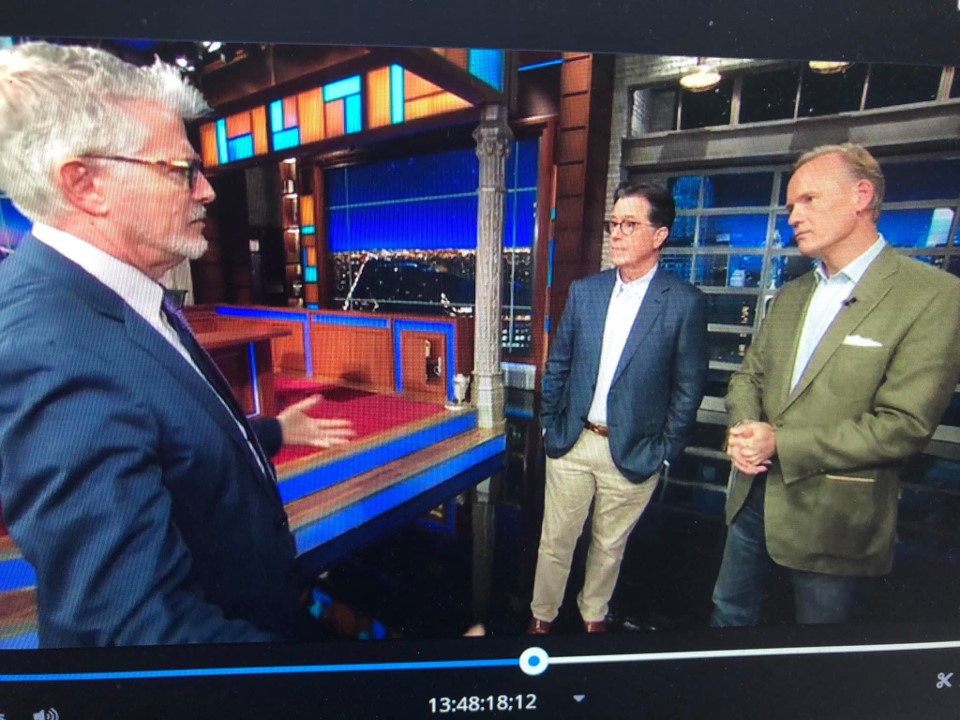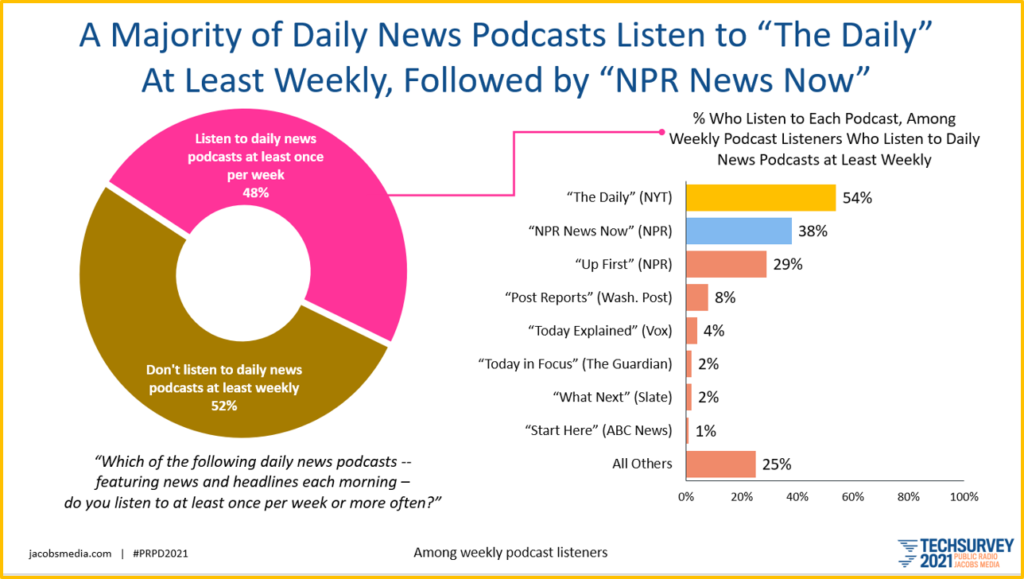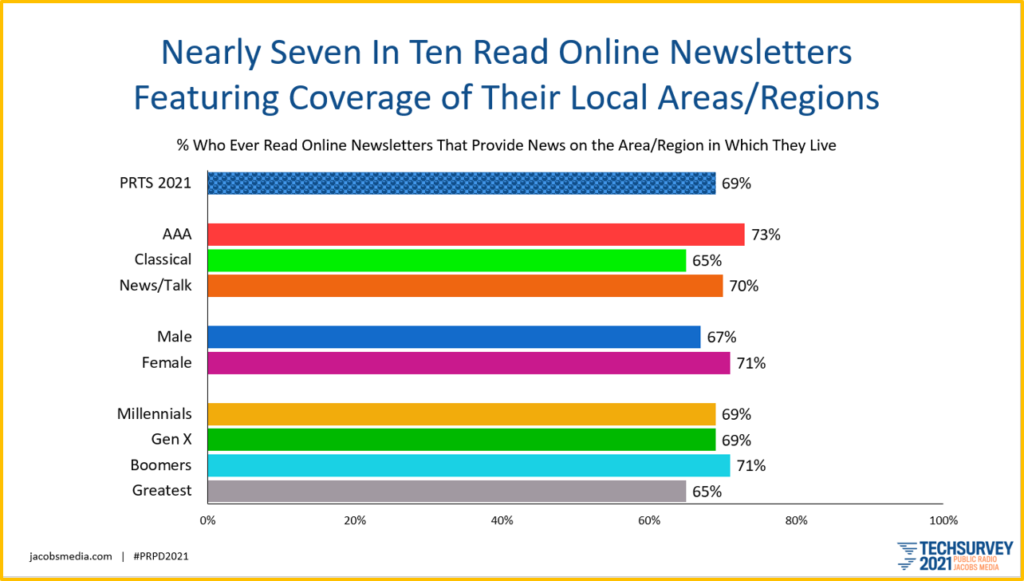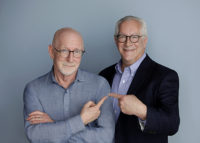
As you’re reading this, hundreds of diligent public radio program directors are convening virtually at their annual conference. Led by public radio vet, Abby Goldstein, PRPD has bobbed and weaved a great deal in recent years in an effort to better serve its tribe of content creators.
Public radio has had quite a run these past few years. Referred to in the system as the “Trump Bump,” 45 created a sense of daily – often hourly – “cume urgency” with his announcements, behavior, statements, orders, and of course, those tweets. The world of news journalism has never seen anything like it, and may not ever again.
Now public radio may be facing a reckoning of sorts. While there are still plenty of mega-headlines each and every day – hurricanes and climate change, the Insurrection, Afghanistan, abortion, COVID, and the California Gubernatorial recall vote – to name just a few – the news bug simply isn’t as voracious in 2021. More of us can wait before we turn on the news, whether it is delivered by local TV, a newspaper, a website, an app, or a public radio station. Some of us are simply burned out on the news.
This will be just one of the topics this year at the PRPD Conference, dubbed “REdefining Public Media” this year. As always, it will feature some of the best and brightest in the space. I am fortunate to be on the agenda this year, thanks to Jacobs Media’s 13th annual Public Radio Techsurvey. Usually, Abby gives me 50 minutes or so to blast through 100 data slides that help explain what’s going on in public radio.
 But because this year is so different, my PRTS 2021 will be quite a bit different, too. I’ll be joined by Paul Jacobs, along with two of the best content creators out there. Ju-Don Marshall is chief content officer and EVP at WFAE Radio in Charlotte.
But because this year is so different, my PRTS 2021 will be quite a bit different, too. I’ll be joined by Paul Jacobs, along with two of the best content creators out there. Ju-Don Marshall is chief content officer and EVP at WFAE Radio in Charlotte.
She was managing editor of the Washington Post’s digital unit, among her other impressive accomplishments. She brings a lot of outside-in thinking to public radio’s existential issues of the day, the types we’ll be dealing with on the panel.

And the session will be moderated by none other than Jay Kernis, a guy who is very well-known to public radio programmers, managers, and leaders. Jay worked for NPR in the early years – the ’70s – as a producer, before joining 60 Minutes where he made some amazing television for 14 years.
He became NPR’s SVP of Programming through the early 2000s – truly a renaissance period for the network. That’s when Paul and I met him.
Jay then shifted to CNN where he became managing editor, before eventually rejoining CBS News were he’s served as producer for the amazing CBS Sunday Morning for the last eight years. Jay has won an Emmy, Peabody, and DuPont-Columbia Awards along his amazing journey.
“Trends and Stories from PRTS 2021” promises to be a unique way for discussing and perhaps even debating what this year’s findings mean to public radio. The virtual audience will have a voice through Abby Goldstein. Jay has already pinpointed a number of “jump ball” topics we’ll be discussing, but the one that I’m hopeful will get some oxygen revolves around emerging news outlets being targeted to, and consumed by, core public radio listeners.
The first is daily news podcasts, a format pioneered not by a radio or audio entity, but by the New York Times. The Daily, launched just four years ago, is hosted by Michael Barbaro who takes listeners on a daily journey focused on key news stories and happenings. As we learned in this year’s study of nearly 23,000 core public radio listeners, nearly half listen to a daily news podcast regularly.
And the winner? By a vast majority, The Daily. NPR’s entries in this space, rank second and third, while there is now a slew of similarly formatted news podcasts struggling in the single digits.

Impressive. This entire news space didn’t exist five years ago. Today, it is redefining the way millions of avid news junkies follow the world each morning, including sizable numbers of public radio listeners.
Oh, did I mention The Daily also became a radio show, syndicated by American Public Media, now reaching more than a million listeners a day?
And then there are newsletters, another genre that has quietly rocketed to success in recent years. In one form or another – paper, then e-mail – these periodic publications have been around since Guttenberg. But now in electronic form, they are helping Americans keep up with what’s happening in their communities, regions, states, and genres of interest.
For the first time this year, we queried about newsletters consumption in PRTS 2021, and it produced some eye-popping results:

Nearly seven in ten (69%) ever read these locally-crafted newsletters, with strong participation among our many demographic breakouts. Again, here’s another rapidly emerging outlet, often launched by out-of-work journalists looking to apply their craft to a different journalistic outlet. And as you can see, they’re clearly having success in the public radio system.
 How did I learn about these newsletters? From my Millennial daughter, Allison Jacobs, of course.
How did I learn about these newsletters? From my Millennial daughter, Allison Jacobs, of course.
Allie is finishing up a successful stint with “Detour Detroit,” a wonderful newsletter here in the Motor City with coverage and a vibe you won’t read in the Free Press, the News, or even the city’s independent paper, the Metro Times. “Detour” was co-founded by Ashley Woods Branch and Kate Abbey-Lambertz, and is a great example of how a local-centric newsletter can have an impact on its community.
As we will no doubt discuss tomorrow at PRPD, public radio stations in New York or Nebraska can participate in either of these newsy endeavors, especially if they’re locally focused. If a national/international daily podcast can have the measure of wild success enjoyed by The Daily, a local or regional version could surely work anywhere. And public radio has the talent and vision to produce these podcasts.
So do many commercial News/Talk and Talk Radio stations. Rather than simply repurposing daily radio shows in podcast form, a daily effort covering the “313” or the “214” or the Bay Area could likely find an audience.
Of course, the same is true of newsletters. Many, many radio stations – public and commercial – are producing them. But given this is largely still a nascent space, how can existing radio news brands create a truly must-read newsletter with stories only they could tell.
nascent space, how can existing radio news brands create a truly must-read newsletter with stories only they could tell.
And all of this begs the question about what other yet-to-be-discovered journalistic outlets are still untapped or ricocheting in some bright person’s brain, yet to be invented.
Despite the impending death of newspapers – clearly an anachronistic news outlet – we may be in the middle of a new Golden Age of journalism, thanks in no small part to smart, innovative news hounds with stories to tell.
As Ju-Don uses the radio dial and podcasts to cover the Charlotte area, and Jay weaves amazing, buzz-worthy stories every week on CBS Sunday Morning, I know both will have a lot to say about innovation in news gathering and telling. Paul and I will do our best to keep up with them.
As Apple unveils its new iPhone today, I think about Steve Jobs and how he viewed the potential disruption caused by invention:
“Innovation is the ability to see change as an opportunity – not a threat.”
In many ways, that’s the challenge facing all of us in broadcast radio – not just in public radio. How can we not just survive, but thrive, in an ecosystem where change is the currency, and innovation is what will provide growth and sustainability?
See you at PRPD.
“REdefining Public Media,” the PRPD Conference, runs through tomorrow, 9/15, on a screen near you. Our panel, “Trends and Stories from PRTS 2021,” starts at 11;30am ET tomorrow. Info about the event is here.
- Media And Technology In 2025: Believe It Or Not! - April 18, 2025
- In Radio, You Just Never Know - April 17, 2025
- The Secret To Making A Great Podcast (And Great Radio) - April 16, 2025




Please stop referring to January 6th as an insurrection. It was not. No one has ever been charged with insurrection involving the January 6th events. Thank you for your honesty
OK, Fred, a comment in each of your two items.
1. Your focus was on daily news podcasts listened to at least once a week. That grabbed my attention. If you listen, say, once or twice a week you are missing the coverage provided on the other days. Mightn’t a listener be better served by listening regularly to a news podcast that comes out only once or twice a week, thus almost certainly capturing plenty of things the listener would miss if his time is spent only with the dailies? An observation: The former by its nature is likely to be more breathless than the latter, whose editors have the time to be a bit more thoughtful in their selection of topics. I glean several of these not-quite-dailies and feel well served by them.
2. Newsletters are good, but the daily newspapers you describe as moribund aren’t going down without a fight. For example, I have a digital subscription to my local newspaper, which emails me a daily list of articles germane to the area where I live. I click on a headline and I’m quickly seeing the content in my browser. How’s that different, really, from the newsletters you describe? Plus I’m supporting local journalism, and on Sundays I get an actual newspaper on my doorstep just to scratch my nostalgic itch. Works for me.
Hey, John, thanks for the comment. Let me clarify a couple things.
First, the daily news podcast questions. You’re right, of course. Companies and journalist produce them want us to listen every day. We’re just trying to learn about their presentation (like cume), rather than how many episodes they hear. In time, we will most likely do that, especially if these shows grow in popularity. I’m assumming they will.
Second, the newspapers. I subscribe to a physical newspaper – the NY Times – on the weekends. I don’t know about you, but I am totally “out of demo,” not even close to what advertisers want. And while you and I may still read newspapers, both circulation and ad sales are swirling downward. The future is sadly grim.
If you came to me with a business plan for a written, text-based news product in 2021, you wouldn’t use the model with buildings, presses, trucks, drivers, and delivery people. You’d hire great journalists, and publish an online edition. Newsletters are simply virtual newspapers, a way for anyone to use journalism skills to launch their own “paper.”
I hope this is helpful, and as always, I appreciate your comments.
Good piece Fred. I believe the reason for the Daily’s success is that it goes deep on one topic, and then gives a few headline blurbs at the end. We can all find current news headlines in many ways. What The Daily is proving is that folks want to go deeper. I believe The Daily also provides a solid example of podcast spawning a radio show (APM’s radio version). The podcast, and the radio show compliment, and promote each other. Synergy at its best, and content flow the “other” way from what we’re used to. (BTW, Jan 6 was indeed an insurrection).
The Daily. Ick. It is popular with public radio audience for sure. I’m about to offer a completely subjective and maybe even flameworthy opinion. (How totally out of character for me, right?) I find the dramatic excess of the host to be tiresome. And I think the success of the show in public radio circles is because…editorial. It is solidly to the left of center. They’ve had some real peccadilloes lately and it would be easy to fault them for making egregiously idiotic mistakes considering their upper-crusty journalistic pedigree. If that’s news to you, then look it up. You may be as shocked as I was. The idea that people are burned out on news seems to have a lot going for it. It may also be the case that some outlets have been banging one side of the bongos for way too long. For anyone who believes public radio is really fair and balanced I offer this next opinion: You remember Air America? It was a failure for many reasons not the least of which was a total failure to market the service and position it against its real competition, public radio. Ok, flame on. What we may be seeing is a generational swing of the cosmic pendulum.
I’m not going to wade into this muck, U.L., so don’t try to bait me. 🙂
All of this talk about fair and balanced, left/right of center, is firmly in the ear of the beholder. Wherever you fall on the political spectrum, however, I think a definitive difference between public radio and pretty much anyone else is the respect for the audience and guests. There is a lack of shouting, name-calling, abject anger, and the other annoyances and indignities present especially on cable news channels.
Another public radio difference is that you actually have a chance to learn something new when you listen. With other news products, this doesn’t happen with much regularity.
That’s all I have. I’ll leave it to you and other readers to duke it out. But I am asking that the discourse is respectful, and doesn’t go down the rabbit hole of crap like it does everywhere. Or else, I’ll hit that “delete” key faster than you can say Hillary Rodham Clinton.
Roger that. Feel free to hit delete as needed. I’m sorry for the rant.
Would never delete you, Lalo. I love your rants. Stop by any time.
Frankly, I think NPR is too “balanced” and that is doing a great disservice to our country.
I took one Journalism class in school but I always remember what the professor said.
If one person says it is raining outside and one person says it is dry, it is not the job of the journalist to report on what both of them said. It is to stick their head out the window and report the truth.
I thought of this when the GOP were trying to smear President Biden with false claims during the campaign and NPR ran an GOP operatives entire 3 minute rant (yes, I noted it) about what hypocrites the Democrats are for not investigating and holding him responsible when they would go after a GOP candidate for those allegations.
Nowhere in the report did the NPR interviewer say the two words that would blow that LIE out of the water – AL FRANKEN.
We can now add two more words that would expose that LIE – Andrew Cuomo.
Both ONLY quit because the Democrat’ held them responsible. Please show me where the GOP held their own accountable since Richard Nixon.
The problem is that LIARS take advantage of “fair and balanced” outlets because all they want is for their LIES to be disseminated. They understand the mere repetition of LIE makes it more plausible to people because now it is in the either.
It is not partisan outlets like Faux News who are doing the most damage to our country. It is “responsible” outlets like NPR and The New York Times who feel they have to report “both sides” when one is a LIE.
Let me let WAPO’s Jennifer Rubin state what “responsible” outlets like NPR must do
From her 9/16 column.
“Finally, why did the media consistently underplay President Donald Trump’s incoherence, and why do they still resist confronting Republicans about their blind loyalty to a crackpot? I do not have a good answer for that one. Perhaps they need to rethink their role. They are not custodians of the myth of moral equivalence between the parties. They are truth-tellers whose prime obligation is to democracy.
AMEN.
Mike, I’m not going to wade into the politics of your comment. That’s not what this blog is for (and there’s plenty of other blogs that are set up for such debates).
Regarding NPR’s approach to news and fairness, you have identified the conflicts that news directors, producers, and reporters have faced these past few years. In the past, there have been agreed-upon standards of “good journalism” that everyone essentially accepted. Everyone tacityly understood the boundary lines. Publications like National Enquirer were known for flaunting those standards, and most citizens with an IQ over 75 knew what they were getting into when they read them in the supermarket line.
Today, those standards have been blurred. Calling out lies, pointing out facts, and telling the truth seem to be objective endeavors, but they are not. And that’s why the “both sidesisms” continue on most news outlets.
NPR and public radio have frustrated some listeners seeking what they think is “truth.” They want public radio to call out the “obvious lies.”
But that doesn’t always square with being objective.
In spite of the ambiguity, NPR and other public radio outlets (like APM and the BBC) remains among the best (if not the best at what they do). They calmly pursue their stories, they provide perspective, they’ve not in a frantic race to be first, and they let their listeners decide. It doesn’t always work, but it still is the best out there (IMO).
Thanks for taking the time to comment.
I agree these news organizations are among the best in what they do but the best thing for the country is not to report on a lie rather than trying to debunk it in the third paragraph.
Liars make up stories – think birtherism – and the media rabidly pursues the charge rather than deciding it is a lie and ignoring it. Michael Cohen reports in his book there were no investigators in Hawaii exploring this bogus story yet the New York Times was calling him every single day for interviews about his LIE.
Were they lazy? Or is it just in a world where people are being bombarded by information, the media are as desperate for eyes and ears as the LIARS?
From Michael Cohen’s book – ”The mainstream media would then write disapproving articles about the made-up story, but they’d always repeated the slander, providing yet more free press as the news cycle started to best resemble the eddy of a flushed toilet.”
And we know what Steve Bannon said about the strategy of “flooding the zone….”.
They know studies have shown the mere repetition of lies makes it more plausible to people.
As Jennifer Rubin says, the media’s job isn’t to perpetuate the myth of moral equivalence. It is an obligation to the truth.
If NPR, The New York Times and the BBC won’t take a stand against being manipulated and will disseminate lies in the interest of “both sides”, then we are doomed and future history books will refer to January 6th as a tourist visit by US patriots because they are yelling louder.
You and I know the answer – Stupid people are entertaining; smart people are boring. Rumors and innuendo are entertaining; facts are boring. Pictures and emotional tear filled people are entertaining; scientific instruction is boring.
News organizations are more profit centers than news organizations.
What was that book – “Amusing ourselves to Death”?